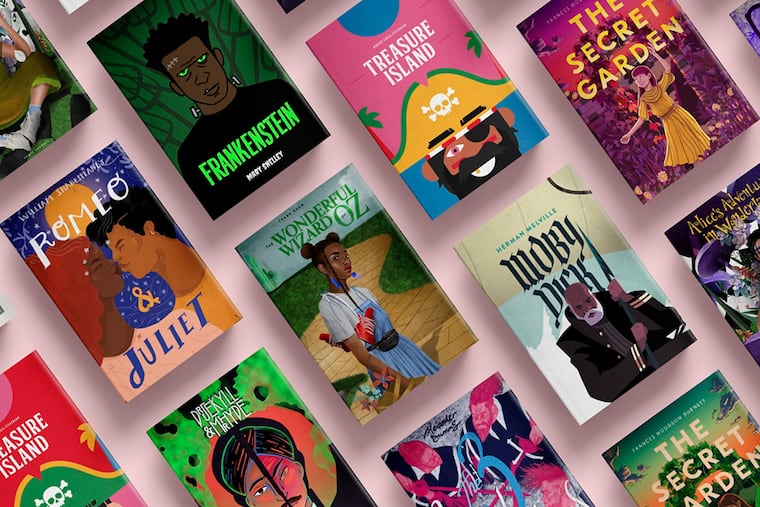Barnes & Noble’s botched black history efforts make a mockery of true efforts toward inclusion | Opinion
Barnes & Noble has canceled its Black History Month plans to re-release classic novels with cover art depicting characters as people of color, following online criticism.

When Barnes & Noble announced plans for a Black History Month display of “Diverse Editions” — new, artist-commissioned covers of classic novels depicting the characters as people of color — at its flagship Fifth Avenue store in Manhattan, a spitstorm of critique erupted in print and online.
“Fake diversity nonsense,” tweeted writer Nnedi Okorafor. The Hate U Give author Angie Thomas snarked, “Here’s a thought. Promote books by authors of color. Just a thought.”
Barnes & Noble swiftly canceled the event, the launch, the whole “Diverse Editions” project.
You might think this initiative was cooked up by some really clueless white people. But you’d be wrong. Turns out the key members of the corporate team behind “Diverse Editions” — honchos from Barnes & Noble, Penguin Random House, and the ad agency TBWA/Chiat/Day — are all people of color. The seven artists who created the new covers were also ethnically and racially diverse.
Here’s what they drew: A Dr. Jekyll/Mr. Hyde in a Sikh-style turban. An indigenous-appearing Alice in Wonderland and an African American Dorothy with crimson high-tops instead of ruby slippers slung over her shoulder. A palette of alternate Romeos and Juliets, including one with the heroine in a headscarf.
And how did the publisher choose which 12 books would be included? Not, for certain, by reading them. The team deployed an artificial intelligence program to speed-scan novels in search of explicit mention of a character’s race or ethnicity.
Turns out, L. Frank Baum never specified that Dorothy was white, nor did J.M. Barrie indicate the shade of Peter Pan’s skin. So those authors’ books, along with Moby-Dick, Treasure Island, and Frankenstein, were considered blank canvases for the “Diverse Editions” color treatment.
But, alas, AI had no grasp of context or subtlety. So it missed the racialized imagery in Moby-Dick or the fact that the female protagonist of The Secret Garden is the daughter of British colonialists who regard Indians as subhuman.
Readers who’ve been left out of the canon — including people of color, queer people, immigrants, those with disabilities — deserve books that depict their lives in three-dimensional and nuanced ways, not books on which their faces are mere decoration.
Didn’t anyone remind the “Diverse Editions” team that you can’t judge a book by its cover? Didn’t anyone in the executive suites where this nut-job idea originated squirm a bit as they imagined a dark-skinned Frankenstein or a Latinx-looking Juliet? Did the word blackface (yellowface, redface) never enter their minds?
The limited-edition custom covers were intended to make classic books “accessible and inclusive” for readers who haven’t seen themselves reflected in the literary canon.
At least, that was the reasoning of Doug Melville, chief diversity officer of TBWA, where the project had its genesis. “Why shouldn’t you be able to … look at a book and be able to pick a cover where you can imagine yourself in it?” he said in an interview with Fast Company.
Great question. But “Diverse Editions” was a shallow and insulting answer, a swipe of brown pigment as a “come-hither” to the same old stories. Readers who’ve been left out of the canon — including people of color, queer people, immigrants, those with disabilities — deserve books that depict their lives in three-dimensional and nuanced ways, not books on which their faces are mere decoration.
Relevance and representation are urgent, volatile issues in publishing at the moment. Just ask the folks at Flatiron Books, who’ve been taking heat for their breathless promotion of American Dirt, a “thriller” about Mexican migrants by a non-Mexican woman (with a Puerto Rican grandmother) who, according to critics of the book, got plenty wrong.
The question that inspired “Diverse Editions” — “What if your favorite literary characters were people of color?” — could lead to a thoughtful critique of the overwhelming whiteness of the publishing world.
And there’s certainly a place for reimagining classic works with nonwhite casting, from 1975’s The Wiz to last summer’s exuberant, all-black version of Much Ado About Nothing in Central Park. There’s fruitful conversation to be had about why, when a character’s race is unspecified, we assume that character to be white, and about the presumed “universality” of some stories while books centering people of color get marginalized.
“Diverse Editions” skirted those questions. And now that the initiative is scrapped, what’s a thinking reader to do? Here are some thoughts: Support organizations and presses that center work by nonwhite (and queer and indigenous) writers. Ask your indie bookstore to feature those authors.
Read books by people of color. Start with something, anything, by the late, great, Toni Morrison, who championed the work of black writers during the 16 years she edited books at Random House. Her birthday is Feb. 18. If news of “Diverse Editions” has made it to wherever magnificent writers go when they die, then Morrison is surely groaning in her grave.
Anndee Hochman is a writer and teacher in Philadelphia.